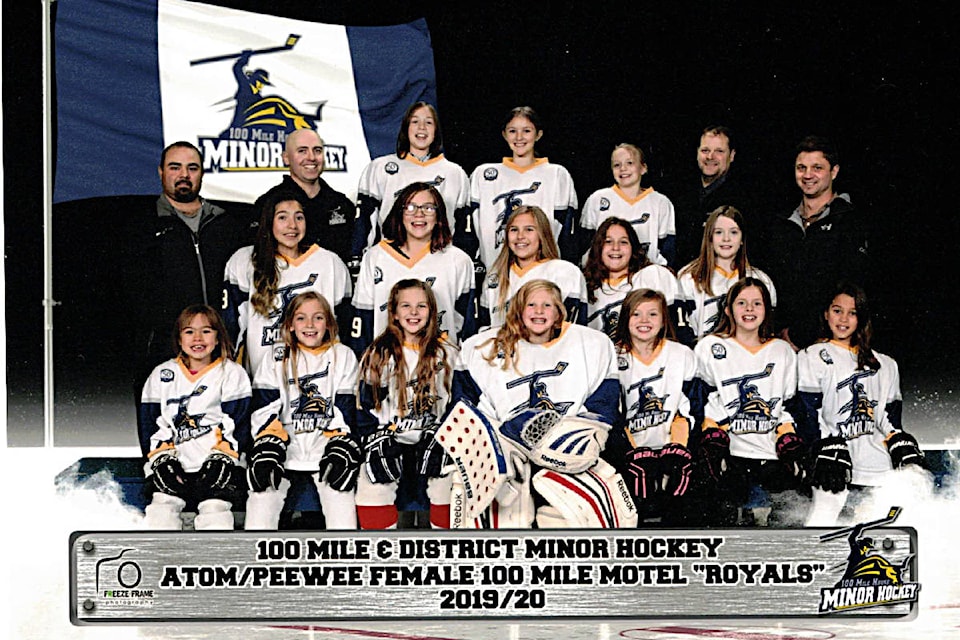“It was funny because we were dressing these little girls in their hockey gear and they’re going ‘grr, we’re tough’ and then ‘you look like a boy’ and I’m trying to tell them ‘you don’t look like a boy, you look like a girl that plays hockey,” Denise Balbirnie, the director of female hockey for the 100 Mile House and District Minor Hockey Association (OMHMHA) about one of the stereotypes young girls face in hockey, recalling a moment during the association’s new school-based program.
Facing the usual stereotype of hockey being just a sport for boys is just one struggle they have to face, but the program has made a couple of big strides in recent years.
“We did have an increase in numbers a couple of years ago when we started our peewee-bantam female team for the first time and we got a few new players that year that had never played before because we didn’t have a female option,” Balbirnie said. “We’re starting to see larger numbers in the lower divisions now, so this time we’ve had an atom-peewee team for the first time this year, so we’re pretty excited about that.”
The peewee-bantam team is now a bantam-midget team and play in the Okanagan Mainline Midget Female Recreation League, along with teams from Kelowna, Kamloops, Lumby and Lillooet.
“It’s going really well,” said Balbirnie, and it is. The team is sitting in third place in the six-team division, with five wins, including a 5-1 win on Jan. 10. Forward Vanessa Betschart has been lighting up the lamp, with 17 goals and six assists. Only Lumby’s Jordyn Morris has more points with 30.
The midget team will also have a busy January, playing a tournament in Kelowna and also attending WickFest in Surrey. They will also host Kelowna during the third week of the month.
But while the program has been successful on the ice and in many ways off of it, the young girls still face some adversity. For example, Balbirnie recalled a time when five of the girls played on a co-ed team. The team played at a high-level tournament, coming in second place. According to her, the talk from the boys was that they did so well in spite of the girls on the team, rather than recognize them as important members of the team.
Co-ed teams are still options in the OMHMHA structure, but the two aforementioned teams are both all-girls teams. The new atom-peewee team doesn’t play in a league though but plays in tournaments and exhibition games, and nearly all the players are dual registrants and play co-ed hockey. Dual-registrations are unique to women’s hockey and isn’t afforded to their male counterparts. It was a measure introduced by BC Hockey and Hockey Canada to encourage girls and women to take up the sport, which has a significantly lower (but growing) participation rate with females.
Because of this, Balbirnie has said that there are also murmurs about preferential treatment towards the all-girl teams. But being in an all-girls team works more in favour for development purposes.
“A lot of people say ‘that’s not good hockey, the best hockey is the mixed’ and ‘that the girls aren’t going to develop in female hockey’ and that it’s ‘all pink and fluff and ribbons and bows.’ It’s not. It’s intense. These girls play hard and they’re coming off the ice and they’re sweating. They’re playing the body and it’s really, really entertaining hockey and the girls are really, really skilled. We’re proud of how far they’ve come,” said Balbirnie. “They think it isn’t as good as co-ed hockey, that’s just not the case. Not even remotely. I find, actually, girls tend to play harder on an all-female team than they do on a co-ed team.”
Balbirnie said the program is focused on growing the association’s programs, female and male, adding that they need one to be strong for the other to be strong. One of the ways they are doing that is a program with the 100 Mile Elementary School, where two classes get three sessions of ice time in full hockey gear with coaches. One of these sessions is where Balbirnie heard the comments students made about looking like boys.
Women’s hockey has a growing profile in North America. For instance, the NHL asked Kendall Coyne Schofield, a former American professional player who played for the Minnesota Whitecaps in the NWHL and an Olympian, to take part in the 2019 NHL All-Star weekend, replacing Colorado’s superstar Nathan MacKinnon. She became the first woman to compete in the skills competition.
“She was fast, she was amazing and I think that’s really important for younger girls to see - female athletes excelling in their sport. I think that makes it better for younger girls to say, ‘yeah, I can do that too,’” said Balbernie.
newsroom@100milefreepress.net
Like us on Facebook and follow us on Twitter.
